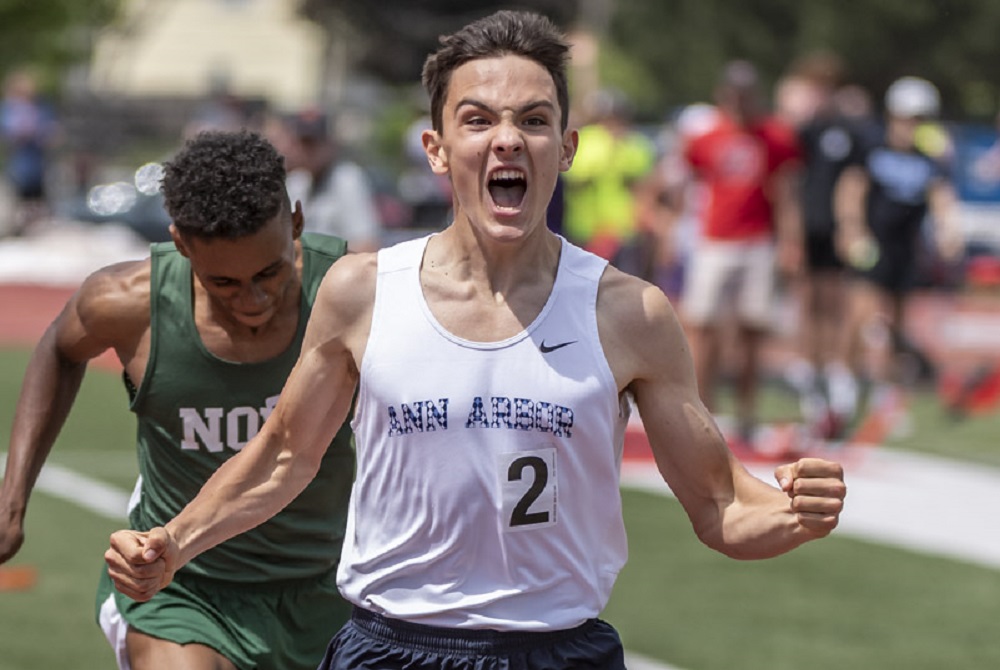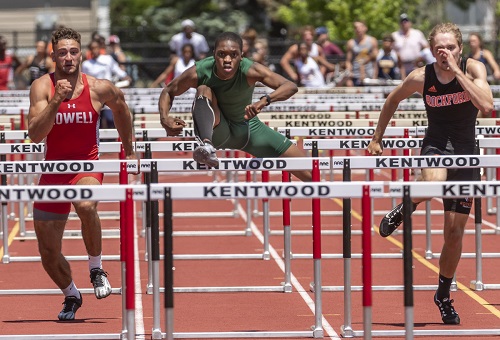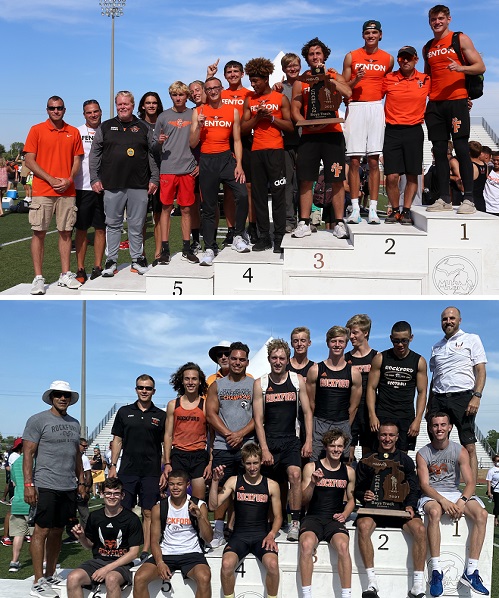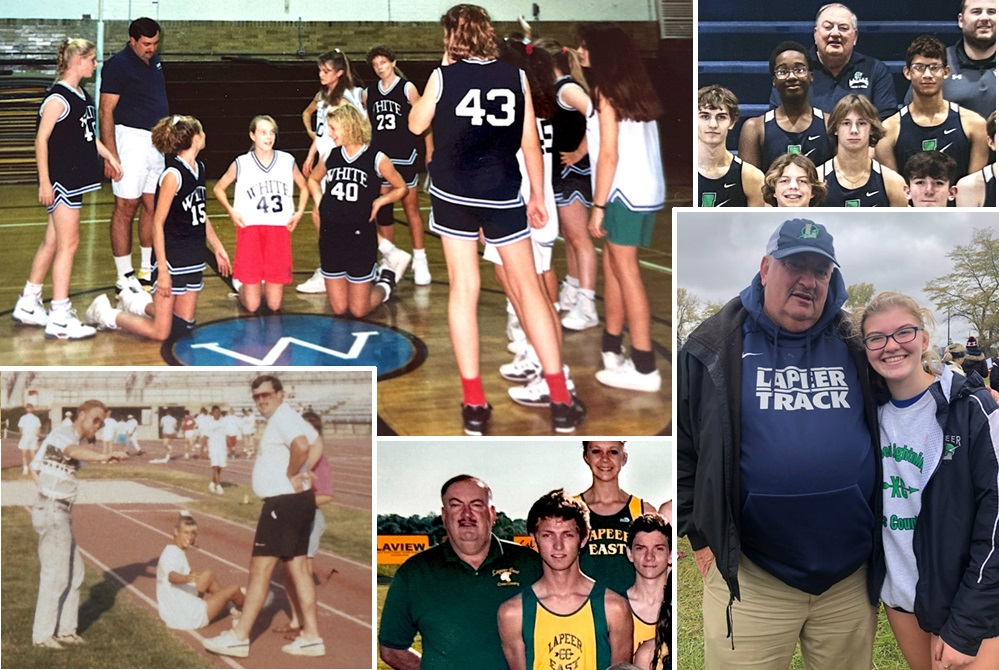
Memorable Wins and Multi-Champs Highlight LPD1 Track's Return
By
Steve Vedder
Special for MHSAA.com
June 5, 2021
KENTWOOD – The particulars didn't necessarily matter to Rockford coach Andrew Martin. The only thing which truly mattered was the stunning finish to Saturday's Lower Peninsula Division 1 boys track & field championships at East Kentwood.
Seemingly out of the running for the team title, the Rams' 1,600 relay – a foursome not even running in the event's fast heat – managed a third place in the final event to earn Rockford a tie with Fenton for first place in a wild meet.
Both teams finished with 34 points. Instead of finishing as low as third place in a meet where the top eight were separated by just 12 points, Rockford earned its first Finals crown in 12 years under Martin.
"It doesn't matter how we got there," Martin said of tying for the title. "We were seeded 10th, but these kids are all about doing your own thing."
The Rams relay was comprised of three seniors in Daniel Leja, Gage Martin and Jacob Peck and junior Jacob Bissell. While they finished with a time of 3:23.84, Fenton was slowed by not having a team qualify for the final relay. It was a turn of events which left Fenton coach Anthony McMillan pacing nervously as the final race played out.
"To still do what we did was great," he said. "These kids left a legacy, a path. To bring a state title home is a very special moment. To be one of the (two) teams means a lot to us."
 Rockford and Fenton were far from the only teams with a breath of life until the final event. Zeeland West finished third with 30 points, Ann Arbor Skyline had 28, Pinckney and Novi 25 and Dexter and Macomb Dakota 24.
Rockford and Fenton were far from the only teams with a breath of life until the final event. Zeeland West finished third with 30 points, Ann Arbor Skyline had 28, Pinckney and Novi 25 and Dexter and Macomb Dakota 24.
While the team title was captivating to the very end, Skyline's Hobbs Kessler virtually stole the individual part of the Finals. Kessler, who became the first Michigan high schooler to qualify for the Olympic trials in 80 years, won the 1,600 (4:16.68) and the 800 (1:54.13). While those finishes weren't necessarily surprises, Kessler's ability to live up to high expectations – including amazing kicks in both events – was even more impressive.
"It's the way I like to win," he said of running his last lap of the 1,600 in 55.1 seconds while also coming from behind to win the 800. "I want to give myself the best shot to win. The wind hit, and I snuck in.
"I know if I work out well and run my best, good things will happen. I know who I have to listen to, and the others aren't as important. I have a good support system, so I can just go out and win."
Kessler qualified for the Olympic trials last Saturday. He said he'll think more about the future now that the high school season is completed. But he wouldn't rule out competing in this summer's Japan Olympics.
"There's no reason to think I can't," he said.
Among the other double winners at East Kentwood were Tamaal Myers II of Detroit Cass Tech, who claimed the 110 hurdles (14.26) and 300 hurdles (37.87), and Udodi Onwuzurike of Bloomfield Hills Brother Rice, who won the 100 (10.55) and 200 (21.23).
Myers said an extremely strong headwind didn't do runners any favors. But he was able to overcome the obstacle because of physical toughness, he said.
"It was a strong wind, but I just pushed through it to finish where I did," he said. "Mentally, you just keep going forward. It's all about technique; it's the arms, legs, everything."
Among other runners winning events were Terrence Muex of Flint Carman-Ainsworth in the 400 (46.52) and Hartland's Riley Hough, who won the 3,200 (9:07.91).
Zeeland West won the 800 (1:28.12) and the 1,600 (3:21.82) relays. St. Joseph won the 400 (42.65) and Novi the 3,200 (7:48.53).
 Dexter's Cole Sheldon won the pole vault (15-3) to complete an inspiring climb that included failing to qualify as a freshmen, to finishing 26th in 2019 to winning Saturday.
Dexter's Cole Sheldon won the pole vault (15-3) to complete an inspiring climb that included failing to qualify as a freshmen, to finishing 26th in 2019 to winning Saturday.
"It was just hard work," said Sheldon, who was seeded fourth. "It's nice being the underdog. I didn't have that great of a Regional, and I told my coach I was saving it for the Finals."
Sheldon also credited teammate Noah Schultz, who finished second with a vault of 14-9.
"That was probably the best thing that could have happened to me," Sheldon said. "He's the reason I did so well. If he goes high, I want to go higher."
Among other field event winners was Zachary Webb of Macomb Dakota, who won the high jump in 6-6. While some competitors are actually surprised by winning a state title, Webb doesn't count himself among them.
"I knew when I came in here I couldn't miss," he said. "I wanted to put the pressure on others, and I think I did that. I practice so much, I knew I could do this. I break down a lot of video. If I'm going bad, I look at the video and fix what I need to fix."
The other field event winners were Drake Willenborg of South Lyon in the discus (183-3), Levi Honderd of Holland in the long jump (22-6) and Ben Haas of Clarkston in the shot put (57-8).
PHOTOS: (Top) Ann Arbor Skyline’s Hobbs Kessler celebrates his victory in the 800 on Saturday. (Middle) Detroit Cass Tech’s Tamaal Myers II sets the pace during his hurdles sweep. (Below) Fenton, top, and Rockford celebrate their team championships.(Action photos by Ike Lea; team photos by John Brabbs/RunMichigan.com.)

'Lapeer Through and Through,' Schmidt Surpasses Half-Century in Coaching
By
Paul Costanzo
Special for MHSAA.com
April 2, 2025
Manny Schmidt still wants to be at track practice.
 After 50-plus years coaching in Lapeer, the man they call Coach Manny has not lost his love for helping student-athletes – and at this rate, he might go another 50.
After 50-plus years coaching in Lapeer, the man they call Coach Manny has not lost his love for helping student-athletes – and at this rate, he might go another 50.
“I told my wife years ago that the first day I don’t feel like going to practice, that I’d rather be somewhere else, that’s the day I’m done,” Schmidt said. “And it hasn’t happened yet. Obviously, you have bad days and things like that. But track, and right now practice, it just keeps me going.”
Schmidt, who is the head boys track & field coach at Lapeer, began coaching track as an assistant in 1974, and has remained there – and Lapeer East, then back at Lapeer when the schools merged back together – ever since. On Friday, April 11, he will be honored at an event at Lightning Rounds in Lapeer for his years of service to Lapeer athletes. The event begins at 7:30 p.m., following the Lapeer Lightning Co-Ed Relays.
“Manny has been a staple of Lapeer Athletics through many different renditions over the years,” Lapeer athletic director Shad Spilski said. “His willingness to help student-athletes grow and achieve their goals is all he wants out of his athletes. Manny spends, and has spent, countless hours over several decades providing athletes multiple opportunities to hone their skills. He not only coaches, but he is one of Lapeer athletes’ biggest fans and supporters. You will always find him at other sporting events cheering on athletes and his coaching colleagues. He truly is Lapeer through and through.”
Schmidt came to Lapeer to teach English in December of 1972 after graduating from Western Michigan University. He had attended high school at St. Joseph Catholic, and was unfamiliar with Lapeer.
But it didn’t take long for him to fall in love with the school community after receiving the assignment.
“Almost immediately,” he said. “I started in December; the teacher had left and I got the job in December. Three days later, they had a staff Christmas party that I got invited to, and all of my close friends over the years, many of them, I guess, I met at that party.”
Coaching was always something Schmidt wanted to do. He played basketball and ran track in high school, and had a basketball coach who made a big impact on his life. He wanted to do the same for others.
In the spring of 1974, during his first full year of teaching English at Lapeer, he got that chance as the assistant track coach. He has since coached cross country – working to start the Lapeer East girls program in the 1990s – junior varsity football and middle school basketball. He also served as a basketball official for more than 30 years.
“I just liked being part of it,” he said.
 Throughout his five decades coaching track, Schmidt has worked with athletes in every event. While middle and long distance are what he’s long enjoyed coaching, he’s currently working with the Lapeer throwers and high jumpers, as head cross country coaches Russ Reitz and Bill Spruytte are also coaching track.
Throughout his five decades coaching track, Schmidt has worked with athletes in every event. While middle and long distance are what he’s long enjoyed coaching, he’s currently working with the Lapeer throwers and high jumpers, as head cross country coaches Russ Reitz and Bill Spruytte are also coaching track.
“In our program, we have four of us (Schmidt, Reitz, Spruytte and Anthony Merlo), and we all have equal voice, we all coach together,” Schmidt said. “On any given day, and that’s the nice thing, I could be with anything. I could be with the hurdlers.”
This past year, Schmidt returned to the Lapeer cross country staff as an assistant, saying he was honored that the current coaches respected him enough to call him back.
But for them, it was an honor to have him.
“Working with Manny is like having access to decades of knowledge,” said fellow cross country assistant Christine Cerny. “It is such a privilege to be able to draw from that and learn from that myself. It’s so awesome to be able to coach alongside him after he has coached my kids.”
During his time, Schmidt has coached multiple generations of Lapeer families, including his own. His children Corrinne and Jennifer both ran for him, as did his grandchildren Morgan, Mason and Colton.
And by his side the entire time has been his wife, Val, who worked as a scorekeeper during meets.
“When I started coaching, she would be the person at all our home cross country meets and all our home track meets who sat there and kept track by hand,” Schmidt said. “Probably the happiest person with this new technology is my wife – now she doesn’t have to do it. When we have invites, she’ll do medals and stuff like that.”
Technological changes have been abundant for high school athletes over the past five decades, not just in competition but outside of it. Schmidt recalls returning to Lapeer from away meets and having athletes line up at the school’s two payphones to call their parents.
“Now, when we get back, everyone has called home and their rides are there waiting,” Schmidt said.
Throughout his time, Schmidt has done plenty of winning and coached several athletes who have moved on to compete at the college level. But the relationships he’s created are what he values most.
“Nobody’s luckier than I am with where I taught and where I coached, and who I’ve coached with over the years,” Schmidt said. “You have to look forward to going to work, and I hate to use the word ‘work’ with coaching. It is, I guess. But there’s just so much good with it.”
 Paul Costanzo served as a sportswriter at The Port Huron Times Herald from 2006-15, including three years as lead sportswriter, and prior to that as sports editor at the Hillsdale Daily News from 2005-06. He can be reached at paulcostanzo3@gmail.com with story ideas for Genesee, Lapeer, St. Clair, Sanilac, Huron, Tuscola, Saginaw, Bay, Arenac, Midland and Gladwin counties.
Paul Costanzo served as a sportswriter at The Port Huron Times Herald from 2006-15, including three years as lead sportswriter, and prior to that as sports editor at the Hillsdale Daily News from 2005-06. He can be reached at paulcostanzo3@gmail.com with story ideas for Genesee, Lapeer, St. Clair, Sanilac, Huron, Tuscola, Saginaw, Bay, Arenac, Midland and Gladwin counties.
PHOTOS (Top) Clockwise from the top left: (1) Manny Schmidt (standing, second from left) coaches the Lapeer White Junior High girls basketball team. (2) Schmidt, top middle, takes a photo with Lapeer’s boys track & field team last spring. (3) Schmidt, left, has coached three of his grandchildren including Morgan Turk. (4) Schmidt, far left, takes a photo with the 2011 Lapeer East cross country teams. (5) Schmidt, standing far right, coaches Michelle Brundage during the 1991 Meet of Champions. (Middle) Schmidt looks on during an event. (Photos provided by the Lapeer athletic department.)

